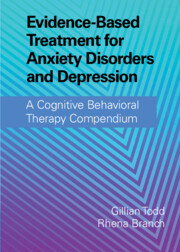 Evidence-Based Treatment for Anxiety Disorders and Depression
Evidence-Based Treatment for Anxiety Disorders and Depression from Part Two - Cognitive Behavioral Therapy for Posttraumatic Stress Disorder
Published online by Cambridge University Press: 06 January 2022
Posttraumatic stress disorder (PTSD) can be effectively treating using a variety of cognitive behavioral therapies. This chapter reviews the evidence base for cognitive behavioral therapies for PTSD, including prolonged exposure (PE), cognitive processing therapy (CPT), and others. Strategies for gold-standard diagnosis and ongoing progress monitoring of PTSD are described, as are considerations for determining readiness for CBT for PTSD. A case formulation of a fictitious patient is presented using emotional processing theory to illustrate one approach to treatment using PE, including therapist scripts for additional guidance. This case formulation includes a focus on socializing patients to PE, which is intended to assist therapists who are new to the model. An overview of the progress of this fictitious but realistic case is presented for demonstrative purposes.
To save this book to your Kindle, first ensure [email protected] is added to your Approved Personal Document E-mail List under your Personal Document Settings on the Manage Your Content and Devices page of your Amazon account. Then enter the ‘name’ part of your Kindle email address below. Find out more about saving to your Kindle.
Note you can select to save to either the @free.kindle.com or @kindle.com variations. ‘@free.kindle.com’ emails are free but can only be saved to your device when it is connected to wi-fi. ‘@kindle.com’ emails can be delivered even when you are not connected to wi-fi, but note that service fees apply.
Find out more about the Kindle Personal Document Service.
To save content items to your account, please confirm that you agree to abide by our usage policies. If this is the first time you use this feature, you will be asked to authorise Cambridge Core to connect with your account. Find out more about saving content to Dropbox.
To save content items to your account, please confirm that you agree to abide by our usage policies. If this is the first time you use this feature, you will be asked to authorise Cambridge Core to connect with your account. Find out more about saving content to Google Drive.